charging MITSUBISHI iMiEV 2014 1.G Owners Manual
[x] Cancel search | Manufacturer: MITSUBISHI, Model Year: 2014, Model line: iMiEV, Model: MITSUBISHI iMiEV 2014 1.GPages: 262, PDF Size: 26.84 MB
Page 2 of 262

Table of contents
123456789101112
Overview Quick indexGeneral information/
Charging
Seat and restraint systemsFeatures and controlsDriving safetyComfort controlsFor emergenciesVehicle care a
nd maintenance
Customer assistance/
Reporting Safety Defects
SpecificationsAlphabetical index
BK0209800US.book 1 ページ 2014年1月14日 火曜日 午前9時26分
Page 3 of 262
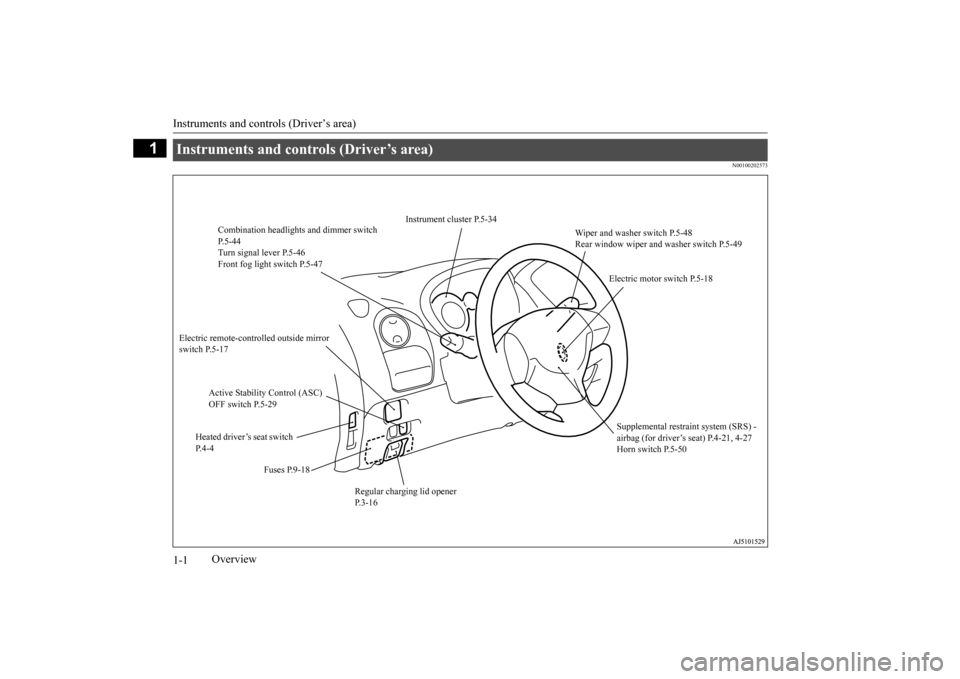
Instruments and controls (Driver’s area) 1-1
1
Overview
N00100202573
Instruments and controls (Driver’s area)
Wiper and washer switch P.5-48 Rear window wiper and washer switch P.5-49
Instrument cluster P.5-34
Combination headlight
s and dimmer switch
P.5-44 Turn signal lever P.5-46Front fog light switch P.5-47
Electric motor switch P.5-18
Electric remote-controlled outside mirror switch P.5-17
Active Stability Control (ASC) OFF switch P.5-29
Supplemental restraint system (SRS) - airbag (for driver’s seat) P.4-21, 4-27Horn switch P.5-50
Heated driver’s seat switch P. 4 - 4
Fuses P.9-18
Regular charging lid opener P.3-16
BK0209800US.book 1 ページ 2014年1月14日 火曜日 午前9時26分
Page 4 of 262
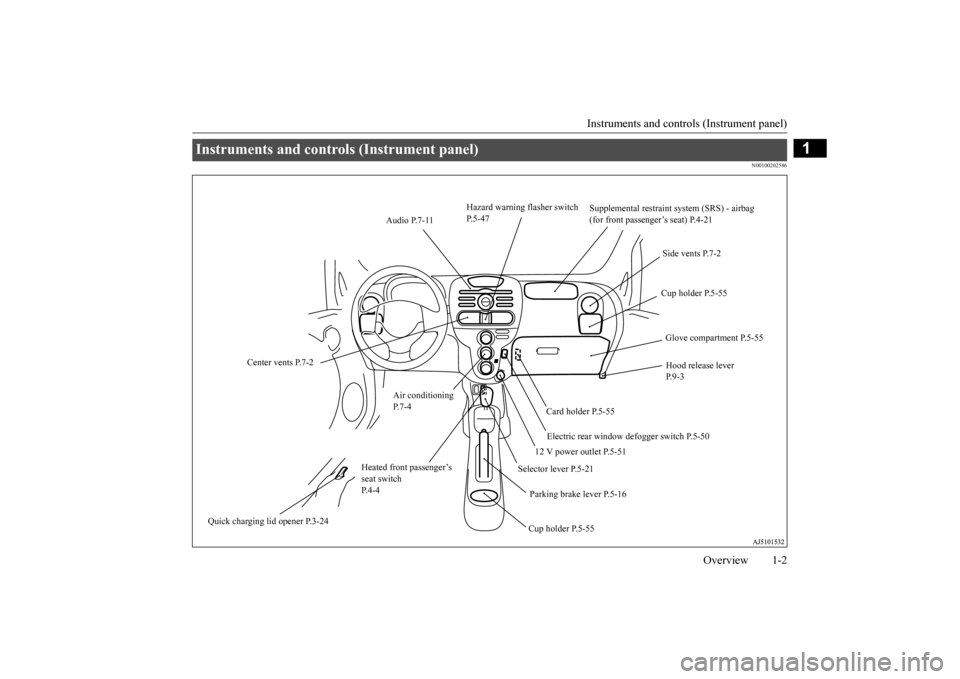
Instruments and controls (Instrument panel)
Overview 1-2
1
N00100202586
Instruments and controls (Instrument panel)
Hazard warning flasher switch P.5-47
Supplemental restraint system (SRS) - airbag (for front passenger’s seat) P.4-21
Audio P.7-11
Side vents P.7-2 Cup holder P.5-55 Glove compartment P.5-55
Center vents P.7-2
Hood release lever P. 9 - 3
Air conditioning P. 7 - 4
Card holder P.5-55 Electric rear window defogger switch P.5-50
12 V power outlet P.5-51
Selector lever P.5-21
Heated front passenger’s seat switchP. 4 - 4
Parking brake lever P.5-16
Quick charging lid opener P.3-24
Cup holder P.5-55
BK0209800US.book 2 ページ 2014年1月14日 火曜日 午前9時26分
Page 7 of 262
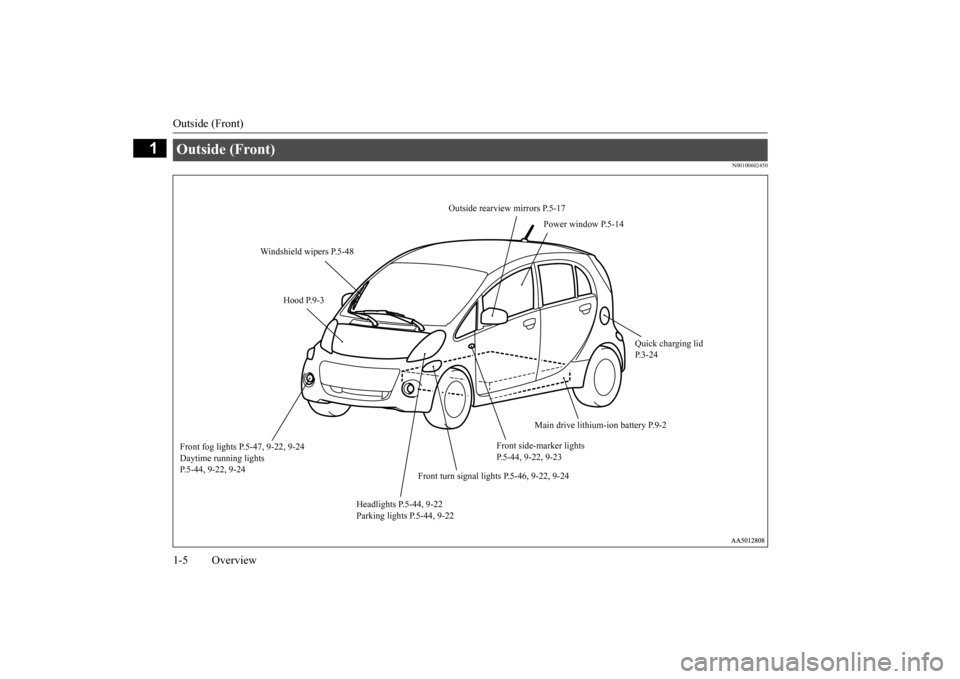
Outside (Front) 1-5 Overview
1
N00100602450
Outside (Front)
Outside rearview mirrors P.5-17
Power window P.5-14
Windshield wipers P.5-48
Hood P.9-3
Quick charging lid P.3-24
Main drive lithium-ion battery P.9-2
Front side-marker lights P.5-44, 9-22, 9-23
Front fog lights P.5-47, 9-22, 9-24 Daytime running lights P.5-44, 9-22, 9-24
Front turn signal lights P.5-46, 9-22, 9-24
Headlights P.5-44, 9-22 Parking lights P.5-44, 9-22
BK0209800US.book 5 ページ 2014年1月14日 火曜日 午前9時26分
Page 8 of 262
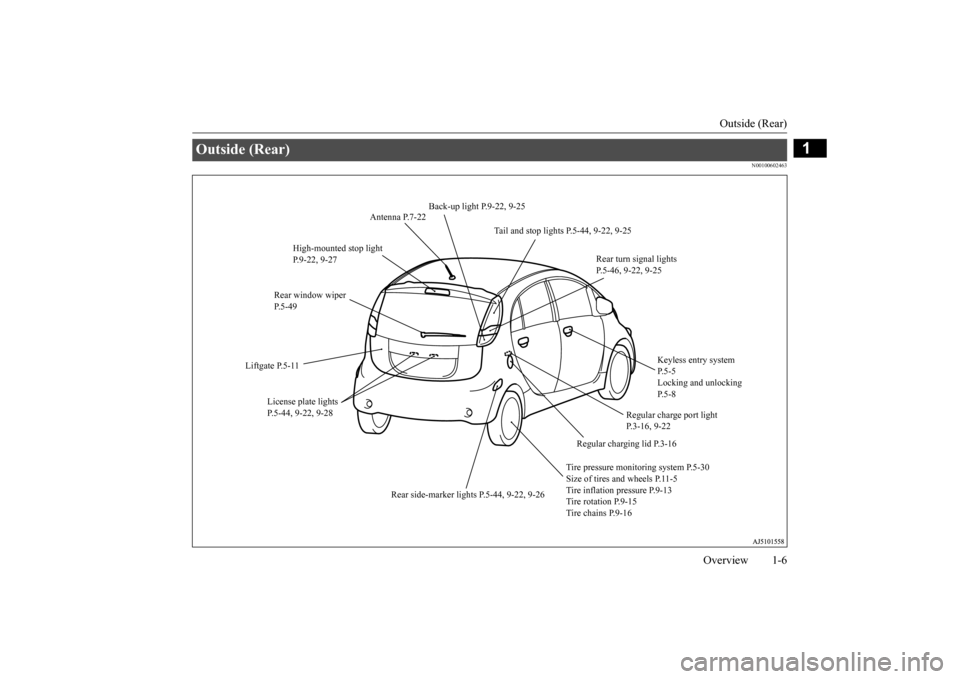
Outside (Rear)
Overview 1-6
1
N00100602463
Outside (Rear)
Back-up light P.9-22, 9-25
Antenna P.7-22
Tail and stop lights P.5-44, 9-22, 9-25
High-mounted stop light P.9-22, 9-27
Rear turn signal lights P.5-46, 9-22, 9-25
Rear window wiper P.5-49
Keyless entry system P. 5 - 5Locking and unlocking P. 5 - 8
Liftgate P.5-11
License plate lights P.5-44, 9-22, 9-28
Regular charge port light P.3-16, 9-22
Regular charging lid P.3-16 Tire pressure monitoring system P.5-30 Size of tires and wheels P.11-5 Tire inflation pressure P.9-13 Tire rotation P.9-15Tire chains P.9-16
Rear side-marker lights P.5-44, 9-22, 9-26
BK0209800US.book 6 ページ 2014年1月14日 火曜日 午前9時26分
Page 10 of 262
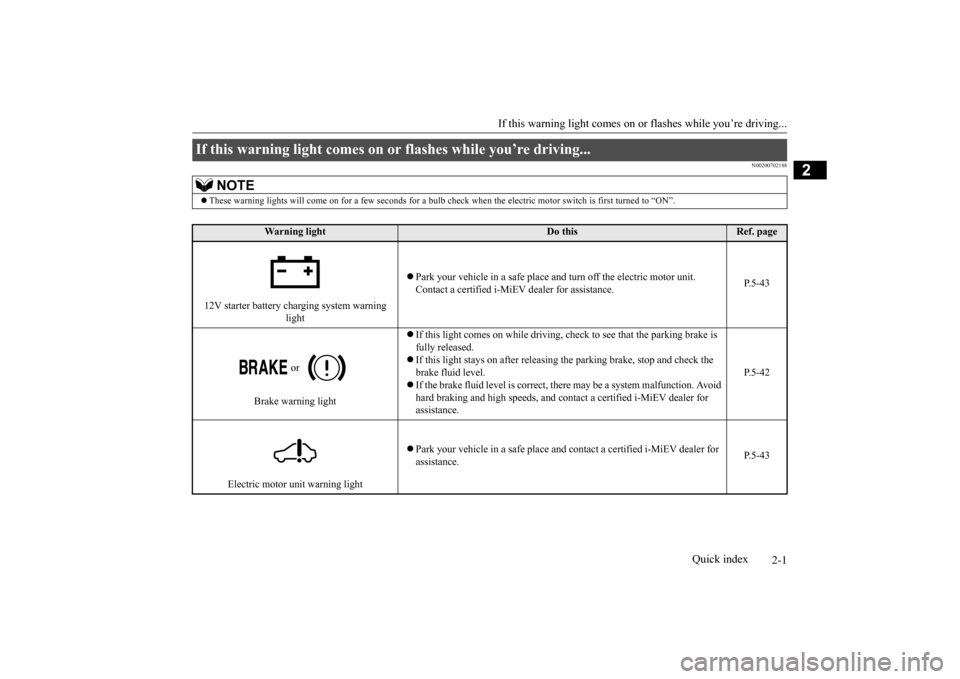
2-1
2
If this warning light comes on or
flashes while you’re driving...
Quick index
N00200702188
If this warning light comes on
or flashes while you’re driving...
NOTE
These warning lights will come on for a few se
conds for a bulb check when the electric
motor switch is first turned to “ON”.
Warning light
Do this
Ref. page
12V starter battery charging system warning
light
Park your vehicle in a safe place a
nd turn off the electric motor unit.
Contact a certified i-MiEV dealer for assistance.
P.5-43
or
Brake warning light
If this light comes on while driving, ch
eck to see that the parking brake is
fully released. If this light stays on after releasing
the parking brake, stop and check the
brake fluid level. If the brake fluid level is correct, ther
e may be a system
malfunction. Avoid
hard braking and high speeds, and cont
act a certified i-MiEV dealer for
assistance.
P.5-42
Electric motor unit warning light
Park your vehicle in a safe place and
contact a certified
i-MiEV dealer for
assistance.
P.5-43
BK0209800US.book 1 ページ 2014年1月14日 火曜日 午前9時26分
Page 16 of 262
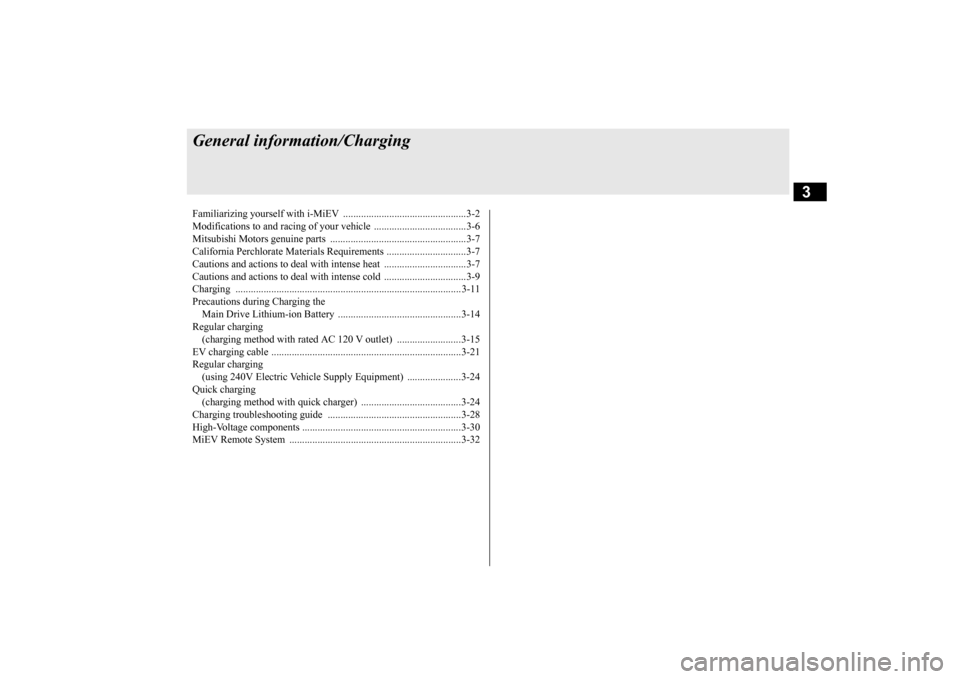
3
General information/ChargingFamiliarizing yourself with i-
MiEV ........
...........
...........
...........
.......3-2
Modifications to and racing of your vehi
cle ...........
...........
.........
.....3-6
Mitsubishi Motors genuine parts .....................................................3-7California Perchlorate Materials Requirements ...............................3-7 Cautions and actions to deal with intense heat ................................3-7 Cautions and actions to deal with intense cold ................................3-9Charging ........................................................................................ 3-11 Precautions during Charging the Main Drive Lithium-ion Battery ................................................3-14Regular charging (charging method with rated AC 120 V
outlet) .....
........
............3-15
EV charging cable ..........................................................................3-21Regular charging (using 240V Electric Vehi
cle Supply Equipment) ..
...................3-24
Quick charging (charging method with quick charger) ..
..............
.........
.........
.....3-24
Charging troubleshooting guide ....................................................3-28 High-Voltage components ......
...........
...........
...........
.........
.........
.....3-30
MiEV Remote System ...................................................................3-32
BK0209800US.book 1 ページ 2014年1月14日 火曜日 午前9時26分
Page 17 of 262
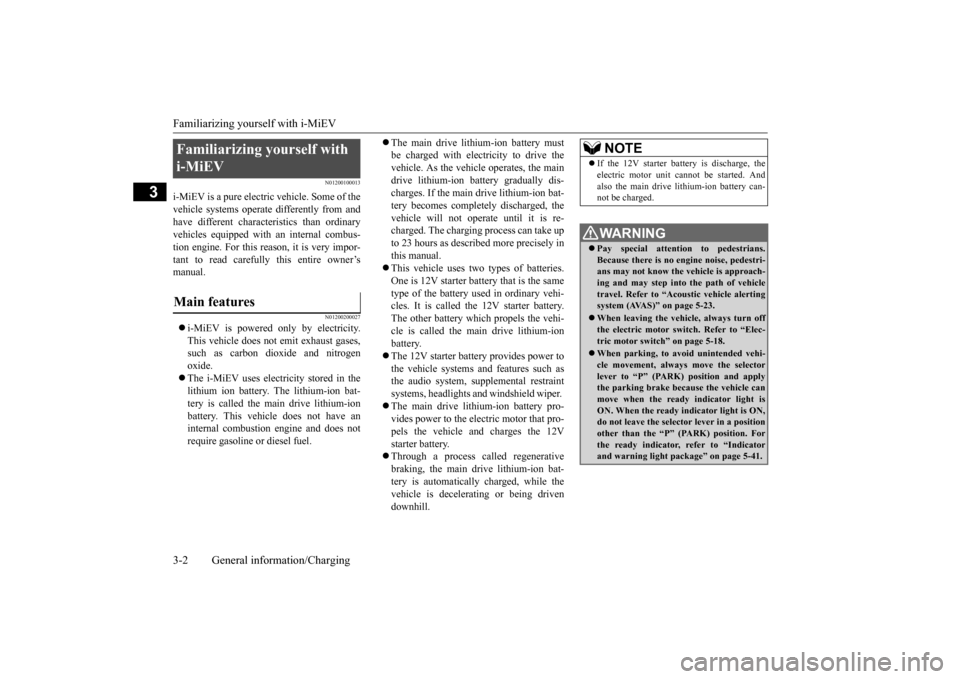
Familiarizing yourself with i-MiEV 3-2 General information/Charging
3
N01200100013
i-MiEV is a pure electric vehicle. Some of the vehicle systems operate differently from and have different characteristics than ordinaryvehicles equipped with an internal combus- tion engine. For this reas
on, it is very impor-
tant to read carefull
y this entire owner’s
manual.
N01200200027
i-MiEV is powered only by electricity. This vehicle does not
emit exhaust gases,
such as carbon dioxide and nitrogenoxide. The i-MiEV uses electricity stored in the lithium ion battery. The lithium-ion bat-tery is called the main drive lithium-ion battery. This vehicl
e does not have an
internal combustion engine and does notrequire gasoline
or diesel fuel.
The main drive lithium-ion battery must be charged with electricity to drive thevehicle. As the vehi
cle operates, the main
drive lithium-ion battery gradually dis- charges. If the main drive lithium-ion bat-tery becomes completely discharged, the vehicle will not
operate until it is re-
charged. The charging process can take upto 23 hours as descri
bed more precisely in
this manual. This vehicle uses two types of batteries. One is 12V starter battery that is the same type of the battery used in ordinary vehi-cles. It is called the 12V starter battery. The other battery which propels the vehi- cle is called the main drive lithium-ionbattery. The 12V starter battery provides power to the vehicle systems and features such asthe audio system, supplemental restraint systems, headlights a
nd windshield wiper.
The main drive lithium-ion battery pro- vides power to the electric motor that pro- pels the vehicle and charges the 12V starter battery. Through a process called regenerative braking, the main drive lithium-ion bat- tery is automatically charged, while thevehicle is decelera
ting or being driven
downhill.
Familiarizing yourself with i-MiEV Main features
NOTE
If the 12V starter batter
y is discharge, the
electric motor unit ca
nnot be started. And
also the main drive lithium-ion battery can-not be charged.WA R N I N G Pay special attention to pedestrians. Because there is no engine noise, pedestri- ans may not know the vehicle is approach-ing and may step into
the path of vehicle
travel. Refer to “Aco
ustic vehicle alerting
system (AVAS)” on page 5-23. When leaving the vehicl
e, always turn off
the electric motor switch. Refer to “Elec-tric motor switch” on page 5-18. When parking, to avoi
d unintended vehi-
cle movement, always move the selector lever to “P” (PARK)
position and apply
the parking brake because the vehicle canmove when the ready indicator light is ON. When the ready indicator light is ON, do not leave the select
or lever in a position
other than the “P” (PARK) position. For the ready indicator,
refer to “Indicator
and warning light pack
age” on page 5-41.
BK0209800US.book 2 ページ 2014年1月14日 火曜日 午前9時26分
Page 18 of 262
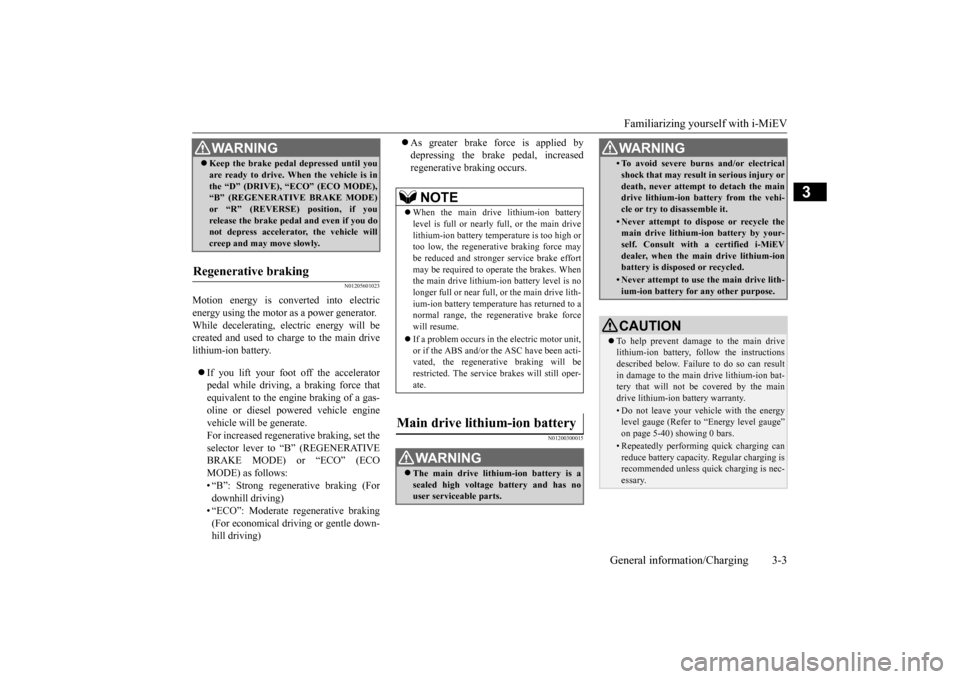
Familiarizing yourself with i-MiEV
General information/Charging 3-3
3
N01205601023
Motion energy is converted into electric energy using the motor as a power generator. While decelerating, electric energy will becreated and used to charge to the main drive lithium-ion battery. If you lift your foot off the accelerator pedal while driving, a braking force thatequivalent to the engine braking of a gas- oline or diesel powered vehicle engine vehicle will
be generate.
For increased regenerative braking, set the selector lever to “B” (REGENERATIVE BRAKE MODE) or “ECO” (ECOMODE) as follows: • “B”: Strong regenerative braking (For downhill driving)• “ECO”: Moderate regenerative braking (For economical driving or gentle down- hill driving)
As greater brake fo
rce is applied by
depressing the brak
e pedal, increased
regenerative braking occurs.
N01200300015
Keep the brake pedal depressed until you are ready to drive. When the vehicle is inthe “D” (DRIVE), “ECO” (ECO MODE),“B” (REGENERATIVE BRAKE MODE) or “R” (REVERSE) position, if you release the brake pedal and even if you donot depress accelerator, the vehicle will creep and may move slowly.
Regenerative braking
WA R N I N G
NOTE
When the main drive lithium-ion battery level is full or nearly
full, or the main drive
lithium-ion battery temperature is too high or too low, the regenerative braking force may be reduced and stronger service brake effortmay be required to operate the brakes. When the main drive lithium-ion battery level is no longer full or near full,
or the main drive lith-
ium-ion battery temperature has returned to a normal range, the regene
rative brake force
will resume. If a problem occurs in the electric motor unit, or if the ABS and/or the ASC have been acti-vated, the regenerati
ve braking will be
restricted. The service brakes will still oper- ate.
Main drive lithium-ion battery
WA R N I N G The main drive lithium-ion battery is a sealed high voltage battery and has nouser serviceable parts.
• To avoid severe burn
s and/or
electrical
shock that may result in serious injury ordeath, never attempt to detach the maindrive lithium-ion battery from the vehi- cle or try to disassemble it.• Never attempt to dispose or recycle themain drive lithium-ion battery by your- self. Consult with a certified i-MiEVdealer, when the main drive lithium-ion battery is disposed or recycled.• Never attempt to use the main drive lith-ium-ion battery for any other purpose.CAUTION To help prevent damage to the main drive lithium-ion battery, foll
ow the instructions
described below. Failure
to do so can result
in damage to the main
drive lithium-ion bat-
tery that will not
be covered by the main
drive lithium-ion battery warranty.• Do not leave your vehicle with the energylevel gauge (Refer to
“Energy level gauge”
on page 5-40) showing 0 bars.• Repeatedly performing quick charging canreduce battery capacity. Regular charging isrecommended unless quic
k charging is nec-
essary.WA R N I N G
BK0209800US.book 3 ページ 2014年1月14日 火曜日 午前9時26分
Page 19 of 262
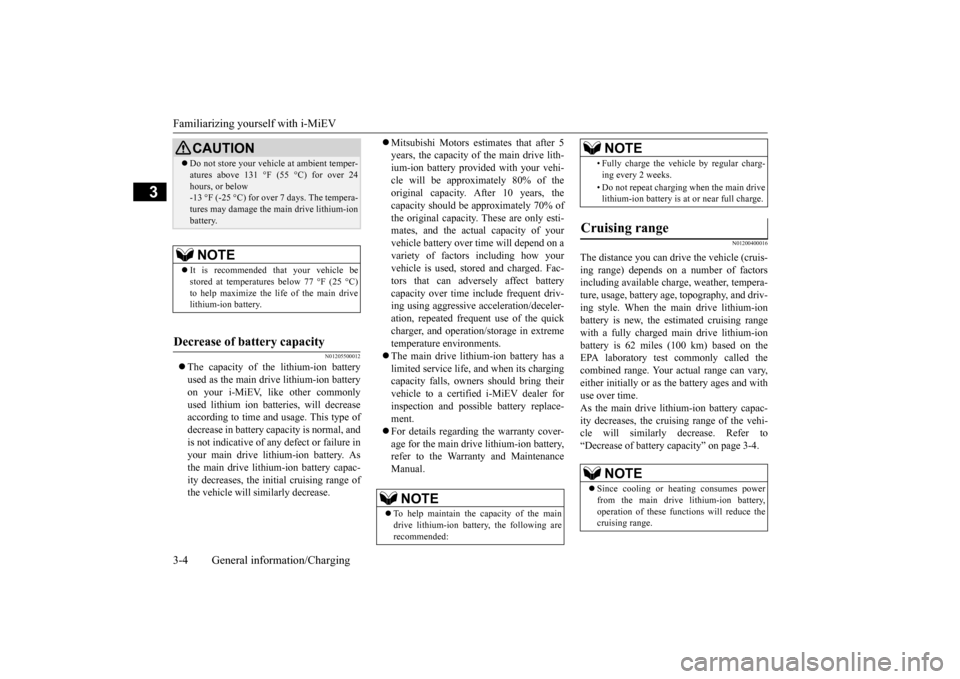
Familiarizing yourself with i-MiEV 3-4 General information/Charging
3
N01205500012
The capacity of the lithium-ion battery used as the main drive lithium-ion battery on your i-MiEV, like other commonly used lithium ion batt
eries, will decrease
according to time and usage. This type of decrease in battery capacity is normal, and is not indicative of a
ny defect or failure in
your main drive lithium-ion battery. As the main drive lithium-ion battery capac- ity decreases, the in
itial cruising range of
the vehicle will si
milarly decrease.
Mitsubishi Motors estimates that after 5 years, the capacity of the main drive lith-ium-ion battery provided with your vehi- cle will be a
pproximately 80% of the
original capacity. Af
ter 10 years, the
capacity should be approximately 70% of the original capacity. These are only esti- mates, and the actual capacity of yourvehicle battery over
time will depend on a
variety of factors including how your vehicle is used, stored and charged. Fac- tors that can adve
rsely affect battery
capacity over time incl
ude frequent driv-
ing using aggressive
acceleration/deceler-
ation, repeated frequent use of the quick charger, and operation/storage in extremetemperature environments. The main drive lithium-ion battery has a limited service life, and when its chargingcapacity falls, owne
rs should bring their
vehicle to a certified i-MiEV dealer for inspection and possible battery replace-ment. For details regardi
ng the warranty cover-
age for the main drive lithium-ion battery,refer to the Warranty and Maintenance Manual.
N01200400016
The distance you can driv
e the vehicle (cruis-
ing range) depends on
a number of factors
including available char
ge, weather, tempera-
ture, usage, battery age, topography, and driv- ing style. When the main drive lithium-ion battery is new, the estimated cruising rangewith a fully charged main drive lithium-ion battery is 62 miles (100 km) based on the EPA laboratory test commonly called thecombined range. Your actual range can vary, either initially or as the battery ages and with use over time.As the main drive lithium-ion battery capac- ity decreases, the cruising range of the vehi- cle will similarly decrease. Refer to“Decrease of battery capacity” on page 3-4.
Do not store your vehicle at ambient temper- atures above 131 °F (55 °C) for over 24hours, or below -13 °F (-25 °C) for over 7 days. The tempera- tures may damage the
main drive lithium-ion
battery.NOTE
It is recommended that your vehicle be stored at temperatures below 77 °F (25 °C)to help maximize the life of the main drive lithium-ion battery.
Decrease of battery capacity
CAUTION
NOTE
To help maintain the capacity of the main drive lithium-ion batter
y, the following are
recommended:
• Fully charge the vehicle by regular charg-ing every 2 weeks. • Do not repeat charging when the main drive lithium-ion battery is at
or near full charge.
Cruising range
NOTE
Since cooling or he
ating consumes power
from the main drive lithium-ion battery,operation of these functions will reduce the cruising range.NOTE
BK0209800US.book 4 ページ 2014年1月14日 火曜日 午前9時26分